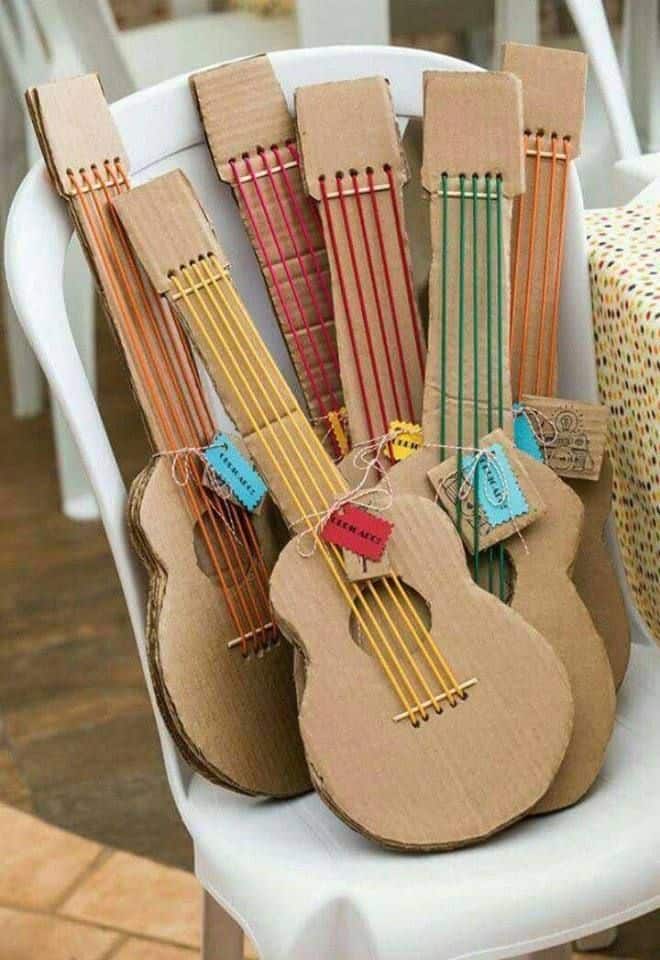Unlock Endless Creativity: Fun & Sustainable Cardboard Craft Ideas for Kids
Hey there, creative parents and crafty kiddos! ? Are you ready to embark on a fantastically fun journey of enchanting creations, all from the comfort of your home? Grab that stack of old cardboard boxes you’ve been saving and let’s turn them into treasures! Cardboard crafts are not just eco-friendly and cost-effective, they’re also a fabulous way to spark imagination and develop fine motor skills. Let’s transform those plain, brown canvases into artistic wonders together!
Why Choose Cardboard for Kids’ Crafts?
Before we jump into the crafty goodness, let’s chat a bit about why cardboard is the *ultimate* go-to material for crafting:
- Eco-Friendly: Cardboard is recyclable and biodegradable, making it a sustainable choice for eco-conscious families.
- Readily Available: With online shopping on the rise, cardboard has become an abundant resource in many homes.
- Versatile: It can be cut, bent, painted, and glued, offering endless possibilities for creative minds.
- Cost-Effective: Using cardboard saves you money, as it repurposes materials you already have at home.
- Safe for Kids: Cardboard is a lightweight and safe crafting material for children to handle and play with.
Getting Prepared: Supplies You’ll Need
Here’s your quick checklist of basic supplies to get those cardboard crafts underway. Most of these items can be found around the house or purchased at a craft store:
- Cardboard boxes of various sizes
- Scissors
- Utility knife (for adult use only)
- Ruler or straight edge
- Pencils and markers
- Paints and brushes
- Glue stick or white PVA glue
- Tape (masking tape, duct tape, or painter’s tape)
- Decorative materials like stickers, glitter, and fabric scraps
Joyful Craft Ideas to Jumpstart Your Cardboard Creations
Okay, let’s roll up those sleeves, get a little messy, and have a whole lot of fun! Here are some delightful craft ideas to get your mini makers inspired:
1. Cardboard Animal Friends
Cut out shapes of animals from cardboard and let your children decorate them with paint, fabric, or colored paper. Whether it’s a roaring lion, a fluttering butterfly, or their imaginary creature, the fun is in the making!
2. A Maze for Marbles
Create a labyrinth of fun by gluing cardboard strips to a flat piece of cardboard, forming a maze. Tip the board to guide a marble through the path – a fantastic activity to enhance problem-solving skills!
3. Build-Your-Own Castle
Every knight and princess needs a castle! Stack and glue cardboard pieces to construct majestic towers and turrets. Don’t forget to add drawbridges, flags, and other royal touches.
4. Personalized Pizza Party
Who doesn’t love pizza? Draw and cut out a pizza shape from a large piece of cardboard, and then cut out various toppings. Your kids can have a blast “baking” and serving up their cardboard creations.
5. DIY Cardboard Vehicles
Let’s travel to places far and wide with cardboard! Cars, trucks, airplanes, and even spaceships can come to life with a little creativity and decoration. These are perfect for both playtime adventures and as cool room decor.
Now that we’re warmed up with ideas, it’s time to dive deeper into the how-tos and step-by-step instructions that will take these concepts from the imaginary runway to liftoff. Rest assured, whether you have toddlers or tweens, we’ve got projects suited for all ages and abilities. So, let’s keep those creative juices flowing and continue exploring the wonderful world of cardboard crafts!
Remember, the beauty of cardboard crafts lies not just in the final product but in the shared experience of creating with your children. So, stay happy, stay creative, and watch as your little ones turn the mundane into the magnificent with simple cardboard magic! Stay tuned for more in-depth tutorials and crafty inspiration that will ensure hours of hands-on fun and learning.

5 Essential Tips for Parents Prepping for Cardboard Craft Time
Before setting out on this grand crafting adventure, it’s always good to be prepared. Here are five key things every parent should know:
Tip 1: Embrace the Mess
Remember, crafting can be messy, but that’s part of the fun. Have a dedicated craft space, whether it’s a tablecloth on the kitchen table or a tarp on the floor. This will make cleanup a breeze and keep those stress levels low. Keep wipes and paper towels handy for quick clean-ups during craft time.
Tip 2: Prioritize Safety
While cardboard is relatively safe to work with, scissors and utility knives can be sharp. Always supervise your kids when they’re using these tools or take over when cutting is required. Storing these items safely away after use will ensure your craft times are not only fun but safe as well.
Tip 3: Be Resourceful
Don’t fret about not having all the craft supplies in the world. The beauty of cardboard crafts is making the most of what you have. Cardboard is a great canvas for creativity, so let your kids use their imagination to repurpose other materials such as bottle caps, toilet rolls, or old magazines for decorating.
Tip 4: Prep Your Materials
Have all your materials ready before inviting the kids to craft. This includes pre-cutting shapes or pieces for younger children. Having everything on hand keeps the creative process flowing and minimizes frustration for the little ones eager to dive right in.
Tip 5: Encourage Creativity, Not Perfection
Crafts are about the process, not just the end product. Encourage your children to experiment and express themselves, even if the result isn’t Pinterest-perfect. Applaud their efforts and creativity; this is a golden opportunity to build their confidence and skills.
Step-by-Step Guide to an Exciting Cardboard Craft
Let’s take a closer look at one of our crafts and break it down into easy-to-follow steps, starting with the Cardboard Castle:
Building a Cardboard Castle Fit for Royalty
A cardboard castle can be as simple or as elaborate as you make it, suitable for kids of all ages. Here’s how to create a basic castle that can be customized to your kiddo’s content:
- Gather Your Materials: Large cardboard boxes, scissors, paint, brushes, a utility knife (for adult use), tape, and markers.
- Construct the Base: Cut out large rectangular pieces for the walls and square pieces for the towers. Tape the corners together to create the walls of your castle.
- Design Your Towers: Fold your square pieces into a tube shape and secure them with tape. If you’re feeling extra crafty, turn them into pointed turrets with triangular pieces of cardboard.
- Attach the Towers: Tape the towers to the corners of your castle walls, reinforcing them so they stand up tall and strong.
- Decorate: Now comes the creative part! Kids can paint the castle, draw bricks with markers, or glue on additional decorative elements like flags made from fabric scraps.
- Add Details: A drawbridge can be made with an extra piece of cardboard attached at the bottom of one castle wall. Cut out windows and doors for more reality.
- Play Time: Once the glue and paint have dried, it’s time to bring in the toy knights and princesses for a grand adventure!
With these steps and tips, creating crafts with cardboard can become a regular family activity that not only entertains but also teaches valuable skills. The process of measuring, cutting, and constructing improves hand-eye coordination and problem-solving, while the decoration phase sparks creativity and self-expression.
So, what are you waiting for? Roll out the cardboard, gather the troops, and let the hours of sustainable crafting commence! Stay tuned as we continue to unravel more crafty inspirations and step-by-step guides to ignite the imaginations of your little ones and create lasting memories!
See more great Things to Do with Kids in New Zealand here. For more information see here
Disclaimer
The articles available via our website provide general information only and we strongly urge readers to exercise caution and conduct their own thorough research and fact-checking. The information presented should not be taken as absolute truth, and, to the maximum extent permitted by law, we will not be held liable for any inaccuracies or errors in the content. It is essential for individuals to independently verify and validate the information before making any decisions or taking any actions based on the articles.




